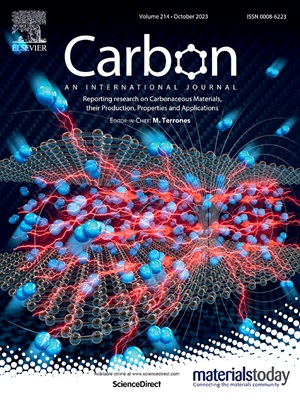Combustion activation synergistic self-templating approaches to construct N-doped honeycomb porous carbon anode for advanced potassium-ion batteries
IF 11.6
2区 材料科学
Q1 CHEMISTRY, PHYSICAL
引用次数: 0
Abstract
The development of high-performance anode materials for potassium-ion batteries remains challenging due to sluggish ion kinetics and structural instability. This study addresses these limitations by preparing nitrogen-doped honeycomb porous carbon (ESC-650) via a self-templated combustion activation strategy to enhance K+ storage, leveraging defect engineering and hierarchical porosity. Owing to the hierarchical pore structure with suitable N doping, ESC-650 exhibits satisfactory K+ storage performance. Specifically, ESC-650 can deliver a high reversible capacity of 321 mAh g−1 at 0.05 A g−1, retaining 89.1 % capacity after 250 cycles. Even at 10.0 A g−1, ESC-650 can also maintain a capacity of 125 mAh g−1, indicating that honeycomb porous carbon can be adapted to the rapid migration of K+, thus possessing favorable rate capability. In situ Raman analysis reveals there are two-state of K+ storage mechanism for ESC-650, which are surface adsorption and vacancy-adsorption accompanied by intercalation processes, respectively. Full-cell tests paired ESC-650 anode with K0.45Mg0.1Fe0.1Mn0.8O2 cathode display a good cycling stability, which underscores ESC-650's potential for practical applications. This work establishes a defect-engineered, hierarchically porous carbon anode that overcomes kinetic barriers in PIBs. The synergistic integration of nitrogen doping and optimized pore architecture enables high-rate capability and long-term cyclability for carbon anode materials.

燃烧活化协同自模板法构建先进钾离子电池掺n蜂窝多孔碳阳极
由于离子动力学缓慢和结构不稳定,高性能钾离子电池负极材料的开发仍然具有挑战性。本研究通过利用缺陷工程和分层孔隙度,通过自模板燃烧激活策略制备氮掺杂蜂窝多孔碳(ESC-650)来增强K+存储,从而解决了这些限制。ESC-650具有良好的分层孔结构和合适的N掺杂,具有良好的K+存储性能。具体来说,ESC-650可以在0.05 a g−1时提供321 mAh g−1的高可逆容量,在250次循环后保持89.1%的容量。即使在10.0 A g−1下,ESC-650也可以保持125 mAh g−1的容量,这表明蜂窝多孔碳可以适应K+的快速迁移,从而具有良好的速率能力。原位拉曼分析表明,ESC-650的K+储存机制存在两种状态,即表面吸附和伴随插层过程的空位吸附。ESC-650阳极与K0.45Mg0.1Fe0.1Mn0.8O2阴极的全电池测试显示出良好的循环稳定性,这表明ESC-650具有实际应用潜力。这项工作建立了一种缺陷工程,分层多孔碳阳极,克服了pib中的动力学障碍。氮掺杂和优化孔隙结构的协同集成使碳阳极材料具有高速率性能和长期循环性。
本文章由计算机程序翻译,如有差异,请以英文原文为准。
求助全文
约1分钟内获得全文
求助全文
来源期刊

Carbon
工程技术-材料科学:综合
CiteScore
20.80
自引率
7.30%
发文量
0
审稿时长
23 days
期刊介绍:
The journal Carbon is an international multidisciplinary forum for communicating scientific advances in the field of carbon materials. It reports new findings related to the formation, structure, properties, behaviors, and technological applications of carbons. Carbons are a broad class of ordered or disordered solid phases composed primarily of elemental carbon, including but not limited to carbon black, carbon fibers and filaments, carbon nanotubes, diamond and diamond-like carbon, fullerenes, glassy carbon, graphite, graphene, graphene-oxide, porous carbons, pyrolytic carbon, and other sp2 and non-sp2 hybridized carbon systems. Carbon is the companion title to the open access journal Carbon Trends. Relevant application areas for carbon materials include biology and medicine, catalysis, electronic, optoelectronic, spintronic, high-frequency, and photonic devices, energy storage and conversion systems, environmental applications and water treatment, smart materials and systems, and structural and thermal applications.
 求助内容:
求助内容: 应助结果提醒方式:
应助结果提醒方式:


